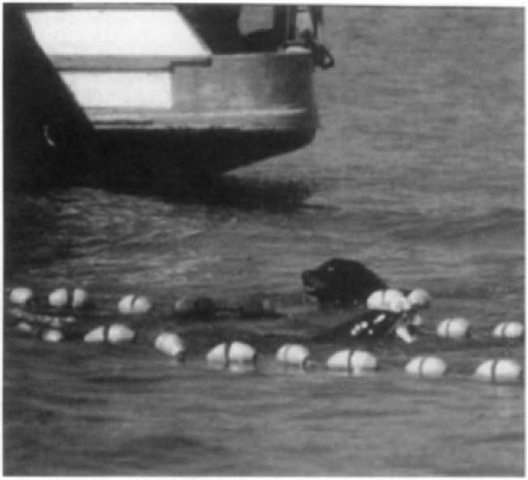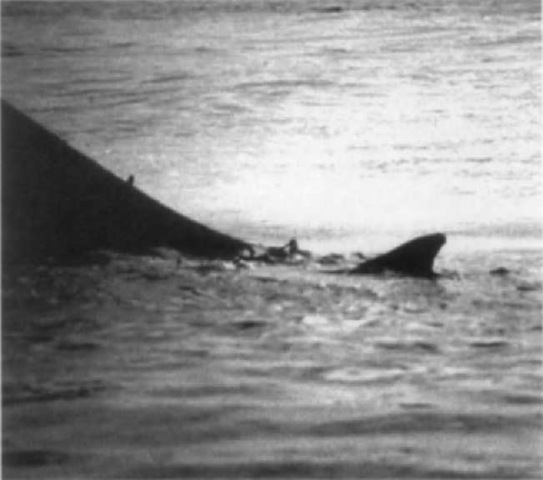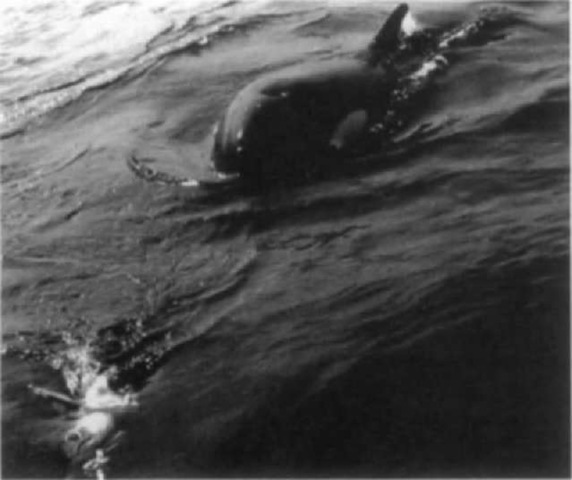Most marine mammal interactions with fisheries may at some time be construed as interference. Interactions may be characterized as biological (ecological) or operational (IUCN, 1981). “Biological” interactions include competition between marine mammals and fisheries for the same prey species, as well as the transmission of parasites between marine mammals and commercial fishery resources. “Operational” interactions are those in which marine mammals take fish from fishing operations, disturb fishing, or damage fishing gear. In some areas, marine mammals are seen as a nuisance, but tolerated as part of the risks involved in fishing. In other locales, marine mammals may be detested as “pests and robbers” and there is a great demand for solutions to be found.
I. Biological Interactions
Marine mammals, particular pinnipeds, may act as intermediate hosts for certain parasites and transmit these to commercial fish species. The most readily recognized example is the codwonn (Porrocaecum decipiens). The gray seal (Halichoerus grypus) is a host to this parasitic nematode, whose larvae infest the muscle tissue of many fish, particularly cod (Gadus morhua). The result is reduced marketability of the fish.
Ecological interactions may result directly when a marine mammal consumes one or more species targeted by commercial fisheries or indirectly if the prey serves as food for other fish species that may be exploited commercially. When commercial fish stocks are in decline and fishing interests seem threatened, conflicts with marine mammals often arise.
II. Operational Interactions A. Depredation
Evidence from some fisheries shows that cetaceans, pinnipeds, and sirenians are attracted to fishing gear and attempt to remove bait and catches. Gear likely to have the most interactions with (and interference from) marine mammals are purse seines, trawls, gill nets, traps, and hooks and lines. Fishing operations concentrate food of interest, decreasing energy expenditure associated with foraging by marine mammals. Nursing females may especially benefit from this feeding technique. Fishing operations may perhaps permit marine mammals to select food of higher caloric value. Some food niches, not otherwise available to some marine mammals, may be opened up, making prey easier to access that might be normally more difficult (e.g., because of depth required to dive).
Feeding in association with fisheries is likely a learned behavior, with increasingly more individual marine mammals seeking out fishing gear for an easy meal. It has also been suggested that this feeding behavior is passed from generation to generation by observation and participation.
Marine mammals may cause abrasions and wounds to fish during unsuccessful capture attempts or while “playing” with fish during fishing operations, even when they are satiated. Fish that are damaged may not be useful to fishermen. It is not known how the number of injured fish relates to the total number killed.
Marine mammals may take portions of fish or the entire fish, rendering them unsaleable. Most estimates of loss vary between 1 and 8% of the total catch. There are exceptions, such as in some longline and salmon gill net fisheries. Various species of cetaceans [e.g., killer whale (Orcinus orca), false killer whale {Pseudorca crassidens), sperm whale) and pinnipeds [e.g., South American sea lion (Otaria flavescens), California sea lion
(Zalophus californianus)] depredate longline-caught fish. Flesh may be torn from hooked fishes or fish may be removed completely as lines are hauled back to the fishing vessel. Estimates of lost catch per attack range from 25 to 100% of the catch (Yano and Dahleim, 1995). Depredation rates may be related to low availability of fish in the area at the time or presence of particular individual marine mammals causing problems.
B. Disturbance
When the mere presence of a marine mammal(s) can cause catches to be reduced and time wasted, fishing operations are disturbed. Cetaceans and pinnipeds may disturb fishing activity by causing fish shoals to disperse or sound (dive rapidly) and thus escape being trapped by the net. Once a marine mammal has located fishing gear, fishermen might have to move to another site or the marine mammal would continue to take substantial amounts of the catch. This disturbance results in cost to the fishermen because they have to move and relocate to fish.
Fishing operations may be impeded in other ways. Seals may be caught in the fish pump (used to remove fish from the net) and die. Fishing operations may be disrupted if live seals are brought abroad in nets or otherwise make their way onto fishing boats, especially if they manage to get below deck. Crew injuries may result from direct interactions with seals, including people being bitten and nylon burns or cut fingers from tug-of-war between a fisherman and a seal.
C. Gear Damage
When a marine mammal attempts to remove fishery catches entangled in a net’s mesh or hooked on a line, holes may be torn or hooks removed. Marine mammals may become incidentally entangled during these encounters; netting and rope may be lost in trying to free live or dead animals. Damaged gear may not fish as efficiently, and a loss of catch may result. Further, repairs may be costly, and the time spent repairing fishing gear may be significant in a seasonal fishery where most of the catch is taken in a period of a few weeks.
There are numerous examples of marine mammals (particularly pinnipeds) damaging fishing gear; there are more reports of damage to static gear (e.g., fish traps, gill nets, longlines) than moving gear (e.g., trawls, purse seines). Gear damage may also result from accidental collision with fishing gear. For example, humpback whales (Megaptera novaeangliae) in Newfoundland in the 1970s caused several hundred thousand dollars of damage annually as a result of colliding with cod traps while feeding on capelein (Mallosus villosus).
Cetaceans and pinnipeds are often blamed for damage to gear or catches that should actually sometimes be attributed to other predators. For example, bottlenose dolphins (Tursiops truncatus) often are blamed for damage to trawl and gill nets when sharks are the real culprits. Although South African fur seals (Arctocephalus australis) are blamed for taking lobsters from traps, clear evidence shows that octopus are to blame. Birds may also be seen taking bait off hooks as they are cast into the water during line fishing.
III. Pinniped Interference with Fisheries
Seals, sea lions, and fur seals take caught fish from nets, hooks, trawls, seines (Fig. 1), or traps and attack fish that are being raised in aquaculture pens. The impact of pinnipeds on fisheries is of particular concern through depredation and gear damage during gill netting on the west coasts of North America, Japan, Britain, Scandinavia, and Chile; through depredation, net damage, and disturbance at fish farms in Britain and Chile; and depredation from trawls, depredation and gear loss from hand lines, and disturbance of purse seining in South Africa (Wickens, 1995). Estimates of the consumption by seals from fishing operations in South Africa show it to be a minimal percentage of fishery catches and a small proportion of the total predation by seals. Preliminary calculations of overall economic losses resulting from these seals’ interference show this to be small (0.3%) in comparison with the wholesale value of the catches.
Figure 1 California sea lions often move into a purse seine net to start feeding before the net is pursed and continue to do so until all the fish are pumped aboard the fishing vessel. Courtesy of Jon Stern.
Some pinnipeds converge on areas where anadromous fish stocks aggregate or where the movements of fish are constrained naturally or artificially (bottleneck or “choke points” where salmonids aggregate in response to human-made structures or natural river physiography, such as fish ladders or below falls, respectively). The most thoroughly studied pinniped/salmonid conflict is California sea lion predation on winter steelhead (On-corhynchus mykiss) at Washington State’s Ballard Locks. The severe decline in salmon is considered primarily a direct result of human activities (Fraker and Mate, 1999); however, much concern has been voiced that the expanding populations of seals and sea lions may be causing a further decline (or impeding the recovery) of various salmon runs in the Pacific Northwest.
IV. Cetacean Interference with Fisheries
Like pinnipeds, cetaceans interact with a diversity of fisheries. Cetaceans may feed on a fishery’s target species, such as killer whales feeding on sablefish (black cod Anoplopoma fimbria) in the North Pacific longline fishery, or on fish that are ancillary to the catch, as in the case of bottlenose dolphins feeding on bycatch from trawl fisheries for shrimp and prawn (Fig. 2). Whales and dolphins may interfere with traps or pots, preying on target species, as well as bait. Long-finned pilot whales (Glo-bicephala melas) in Newfoundland frequent traps to remove the target species squid. Bottlenose dolphins in Belize have been observed retrieving fish from local, homemade fish traps, whereas this species in the Indian River Lagoon in Florida interacts with the crab pot fishery, apparently to steal bait fish. Bottlenose dolphins and “blackfish” (e.g., killer whales, false killer whales, pilot whales) are notorious fish stealers, and there are widespread reports of catch and gear damage by these species (Fig. 3).
V. Sirenian Interference with Fisheries
Fishermen in Jamaica and Sierra Leone have complained about damage caused to gill nets by “net-robbing” West Indian and West African manatees (Trichechus manatus and T. sene-galensis), respectively. Manatees have been described as stripping the flesh off fish entangled in gill nets and leaving the bones.
VI. Toward Solutions
Fishermen use various means to deter marine mammals in an attempt to safeguard their catches and gear. Lethal methods have been attempted, including shooting at or killing the marine mammal with a variety of objects and methods, sometimes involving poison. Sometimes these practices are illegal. Seals have been persecuted much more intensely than cetaceans.
Culls or control programs for marine mammals have been carried out with the expectation that they will increase fishery yields by reducing marine mammal predation on fish stocks (Earle, 1996). One of the best-known culls occurred at Iki Island in Japan between 1976 and 1982. Thousands of bottlenose dolphins and hundreds of Pacific white-sided dolphins (Lagenorhynchus obliquidens) false killer whales, and Risso’s dolphins (Grampus griseus) were killed in response to declines in catches of yellowtail (Seriola dorsalis). The annual Canadian commercial hunt for harp seals (Pagophilus groenlandicus) and hooded seals (Ctjstophora cristata) in the Gulf of St. Lawrence and Newfoundland is conducted to boost the recovery of overfished cod stocks. Scientific evaluation of a proposal to cull marine mammals for the purpose of benefiting commercial fisheries needs to consider the complexity of ecological interactions among the marine mammal population(s), the relevant fish stocks, and the fishery/fisheries that catch them.
Figure 2 Bottlenose dolphins pluck fish from the meshes of shrimp trawl nets. Mesh from nets may be damaged in the process.
Figure 3 Killer whales depredate longline fisheries around the world. This killer tvhale is feeding on a longline-caught bluenose (Hyperoglyphe antarchia) in Neiv Zealand.
Lethal methods have not been found to be a consistently effective means of keeping pinnipeds from interacting with fishing operations. The idea is that if problems are caused by a few rogue seals, then removal of these animals should eliminate the problem. However, this method removes individuals that are then often replaced by others.
A diversity of nonlethal methods has been attempted (Jefferson and Curry, 1996). At the most basic level, fishermen throw stones or bait to distract the predator. Other methods used include firing gunshots, using explosives (such as firecrackers and seal bombs), biological sounds (vocalizations from a predator, killer whale), gear modifications (such as mechanical and electronic sound generators), vessel chase, tactile harassment (e.g., rubber bullets), visual signals, and taste aversion (baiting fish using a chemical to induce vomiting). Acoustic “harassment” devices (AHDs) have been widely used to attempt to reduce depredation on fish, especially by pinnipeds (Reeves et al, 1996). Pinnipeds are difficult to deter by acoustic methods, and the acoustic signal of the AHDs over time was a “dinner bell” effect, alerting animals to the presence of a fish pen or trap. New high-intensity AHDs appear to be effective, but have a greater potential for causing hearing damage, as well as affecting nontarget species. In some cases, a problem may be eased by changing the location of the fishing effort. The most successful mitigation measures appear to be changes to fishing gears or fishing methods where a particular change may reduce or exclude problems, thereby resulting in a permanent solution. Implementation of antipredator cages around fish farms, physical barriers at the entrance of fish ladders, and the change to synthetic twine in gill nets are some examples.
Capture and relocation of “problem” pinnipeds has proven ineffective, with the animals returning to the problem area. California sea lions have been captured at the Ballard Locks and placed in temporary captivity and released after the steel-head run. This proved ineffective in the long term, as did permanent captivity, which eliminates the “problem” sea lions without having to kill them but is limited by the availability of facilities that can hold the sea lions and the costs involved in capturing and holding the animals.
Past efforts have been unsuccessful in finding effective, long-term, nonlethal approaches to eliminating or reducing marine mammal-fishery conflicts. Some nonlethal deterrence measures appear to be effective initially or effective on “new” animals, but become ineffective over time or when used on “new” animals in the presence of “repeat” animals that do not react to deterrence. Further research on the development of new technologies and techniques is needed.



